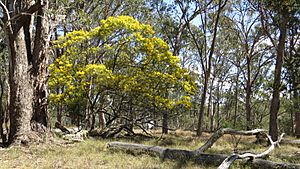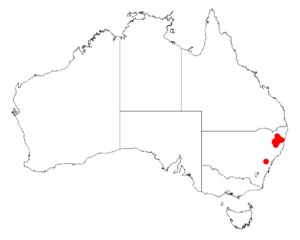Ingram's wattle facts for kids
Quick facts for kids Ingram's wattle |
|
|---|---|
 |
|
| Ingram's Wattle, Acacia ingramii, Wollomombi Falls, Oxley Wild Rivers National Park, NSW, Australia | |
| Scientific classification | |
| Genus: |
Acacia
|
| Species: |
ingramii
|
 |
|
| Occurrence data from AVH | |
Acacia ingramii, commonly known as Ingram's wattle, is a type of shrub or small tree. It belongs to the large Acacia family, which is famous for its many different species found across Australia. This special wattle grows naturally in certain parts of north-eastern Australia.
What Ingram's Wattle Looks Like
This plant usually grows as a shrub or a small tree. It can reach a height of about 2 to 5 meters (that's roughly 6 to 16 feet tall!). It often has a bushy shape with branches spreading out.
The bark on its trunk is smooth and grey. Closer to the ground, it can look a bit wrinkly or corrugated. Its younger branches are often angled or rounded and covered in soft, whitish hairs. New shoots on the plant have a yellowish, silky look.
Like many Acacia species, Ingram's wattle doesn't have true leaves. Instead, it has what are called phyllodes. These are flattened leaf stems that look and act like leaves. The phyllodes of Ingram's wattle stay green all year round. They are straight or slightly curved and have a long, narrow shape. They measure about 7 to 14 centimeters (about 3 to 5.5 inches) long and 1.5 to 3.5 millimeters (about 0.06 to 0.14 inches) wide. These phyllodes are covered in yellow or whitish soft hairs. You can easily see a main vein running down the middle, but the other veins are harder to spot. Each phyllode ends in a sharp point.
How Ingram's Wattle Got Its Name
This specific wattle was first officially described by a botanist named Mary Tindale in 1978. She wrote about it in a scientific journal called Telopea.
For a short time in 2003, another botanist, Leslie Pedley, reclassified it under a different genus, calling it Racosperma ingramii. However, by 2006, it was moved back to the Acacia genus.
The plant's scientific name, ingramii, is a special way to honor Cyril Keith Ingram. He was the first person to realize that this plant was a new species of wattle.
Where Ingram's Wattle Grows
Ingram's wattle has a limited natural home. It grows in the upper part of the Macleay River basin in New South Wales, Australia. You can find it mainly to the east of a town called Armidale.
It is quite common in the steep gorges of the escarpment, which are like deep valleys with cliffs. These areas stretch from around Apsley Falls to Wollomombi Falls. You can also find it in the Guy Fawkes River National Park. This wattle usually grows in low woodlands or open forests, especially in areas with very steep terrain.

